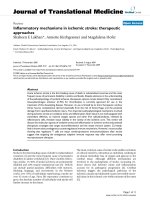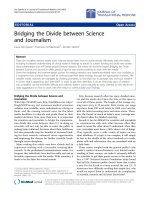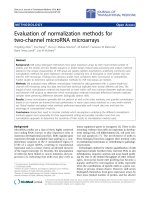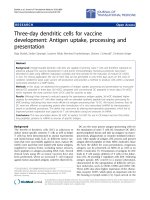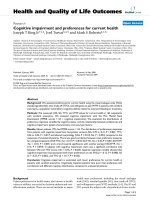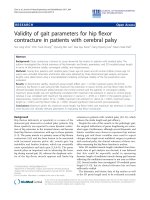báo cáo hóa học:" Decision tree-based acoustic models for speech recognition" potx
Bạn đang xem bản rút gọn của tài liệu. Xem và tải ngay bản đầy đủ của tài liệu tại đây (436.68 KB, 32 trang )
This Provisional PDF corresponds to the article as it appeared upon acceptance. Fully formatted
PDF and full text (HTML) versions will be made available soon.
Decision tree-based acoustic models for speech recognition
EURASIP Journal on Audio, Speech, and Music Processing 2012,
2012:10 doi:10.1186/1687-4722-2012-10
Masami Akamine ()
Jitendra Ajmera ()
ISSN 1687-4722
Article type Research
Submission date 21 April 2011
Acceptance date 17 February 2012
Publication date 17 February 2012
Article URL />This peer-reviewed article was published immediately upon acceptance. It can be downloaded,
printed and distributed freely for any purposes (see copyright notice below).
For information about publishing your research in EURASIP ASMP go to
/>For information about other SpringerOpen publications go to
EURASIP Journal on Audio,
Speech, and Music Processing
© 2012 Akamine and Ajmera ; licensee Springer.
This is an open access article distributed under the terms of the Creative Commons Attribution License ( />which permits unrestricted use, distribution, and reproduction in any medium, provided the original work is properly cited.
Decision tree-based acoustic models for speech recognition
Masami Akamine*
1
and Jitendra Ajmera
2
1
Toshiba Corporate R&D Center, 1, Komukai Toshiba, Saiwai, Kawasaki 212-8582,
Japan
2
IBM Research Lab., 4 Block C, Institutional Area, Vasant Kunj, New Delhi 110070,
India
*Corresponding author:
Email address:
JA:
Abstract
This article proposes a new acoustic model using decision trees (DTs) as replacements for
Gaussian mixture models (GMM) to compute the observation likelihoods for a given
hidden Markov model state in a speech recognition system. DTs have a number of
advantageous properties, such as that they do not impose restrictions on the number or
types of features, and that they automatically perform feature selection. This article
explores and exploits DTs for the purpose of large vocabulary speech recognition. Equal
and decoding questions have newly been introduced into DTs to directly model gender-
and context-dependent acoustic space. Experimental results for the 5k ARPA wall-street-
journal task show that context information significantly improves the performance of DT-
based acoustic models as expected. Context-dependent DT-based models are highly
compact compared to conventional GMM-based acoustic models. This means that the
proposed models have effective data-sharing across various context classes.
Keywords: speech recognition; acoustic modeling; decision trees; probability estimation;
likelihood computation.
1. Introduction
Gaussian mixture models (GMMs) are commonly used in state-of-the-art speech
recognizers based on hidden Markov models (HMMs) to model the state probability
density functions (PDFs) [1]. These state PDFs estimate the likelihood of a speech sample,
X, given a particular state of the HMM, denoted as P(X|s). The sample X is typically a
vector representing the speech signal over a short time window, e.g., Mel frequency
cepstral coefficients (MFCCs). Recently, some attempts have been made to use decision
trees (DTs) for computing the acoustic state likelihoods instead of GMMs [2–6].
a
While DTs are powerful statistical tools and have widely been used for many pattern
recognition applications, their effective usage in ASR has mostly been limited to state-
tying prior to building context-dependent acoustic models [7]. In DT-based acoustic
modeling, DTs are used to determine the state likelihood by asking a series of questions
about the current speech observation. Starting from the root node of the tree, appropriate
questions are asked at each level. Based on the answer to the question, an appropriate
child node is selected and evaluated next. This process is repeated until the selected node
is a leaf node, which provides the pre-computed likelihood of the observation given the
HMM state. The question at each node can involve a scalar or a vector value.
In [2], Foote treated DTs as an improvement of vector quantization in discrete acoustic
models and proposed a training method for binary trees with hard decisions. We view a
DT in [3, 5] as a tree-based model with an integrated decision-making component. In [5],
we proposed soft DTs to improve robustness against noise or any mismatch in feature
statistics between training and recognition. Droppo et al. [4] explored DTs with vector-
valued questions. However, in each of these, only simple tasks such as digit or phoneme
recognition have been explored.
DTs are attractive for a number of reasons including their simplicity, interpretability, and
ability to better incorporate categorical information. If used as acoustic models, they can
offer additional advantages over GMMs: they make no assumptions about the distribution
of underlying data; they can use information from many different sources, ranging from
low-level acoustic features to high-level information such as gender, phonetic contexts,
and acoustic environments; and they are computationally very simple. Prior to this article
these advantages have not fully been explored.
This article explores and exploits DTs for the purpose of large vocabulary speech
recognition [7]. We propose various methods to improve DT-based acoustic models
(DTAMs). In addition to the continuous acoustic feature questions previously asked in the
DTAMs, the use of discrete category matching questions (e.g., gender = male), and
decoding state-dependent phonetic context questions are investigated. We present various
configurations of a DT forest, i.e., a mixture of DTs and their training.
The remainder of this article is organized as follows. Section 2 presents an overview of
the proposed acoustic models including model training. Section 3 introduces equal and
decoding questions and Section 4 presents various ways of realizing the forest. Section 5
presents the experimental framework and evaluation of various proposed configurations.
Finally, Section 6 concludes this article.
2. DT-based acoustic models
As shown in Figure 1, DTAMs are HMM-based acoustic models that utilize DTs instead
of GMMs to compute observation likelihoods. A DT determines the likelihood of an
observation by asking a series of questions about the current observation. Questions are
asked at question nodes, starting at the root node of the tree, ending at a leaf node that
contains the pre-computed likelihood of the observation given the HMM state.
Throughout this article, we assume that DTs are implemented as binary trees. DTs can
deal with multiple target classes at the same time [8] and this makes it possible to use a
single DT for all HMM states [4]. However, we found from preliminary experiments that
better results are obtained by using a different tree for each HMM state of a context-
independent model set. We deal with only hard decisions in this article whereas we
proposed soft decisions in [5]. It is straightforward to extend the methods presented in
this article to soft decisions. At each node, questions are asked about the observed
acoustic features of the form, for example, where x
j
is the jth element of the
observed acoustic feature vector X, with numerical values, and s
d
is the corresponding
threshold. This type of question is referred to as an acoustic (numerical) question.
Each DT is trained to discriminate between the training data that correspond to the
associated HMM state (“true” samples) and all other data (“false” samples). The scaled
likelihood of the D-dimensional observation X = (x
1
, x
2
, …,x
j
, , x
D
) given state q can
then be computed using:
(1)
where is the posterior probability of state q given observation , is the
prior probability of state q, and P(X) is the probability of observation. P(X) is
independent from the questions asked in the DT and is ignored in training and decoding.
The likelihood given by the above equation is stored in each leaf node.
The parameter estimation process for the DTs consists of a growing stage, followed by an
optional bottom-up pruning stage. A binary DT is grown by splitting a node into two child
nodes as shown in Figure 2. The training algorithm considers all possible splits, i.e.,
evaluating every feature and corresponding threshold, and selects the split that maximizes
the split criterion and meets a number of other requirements. Specifically, splits must pass
a chi-square test and must result in leaves with a sufficiently large number of samples.
This helps us avoid problems with over-fitting. For this article, the split criterion used
was the total log likelihood increase of the true samples. Other criteria such as entropy
impurity or Gini impurity can be used. There are two reasons why we use the likelihood
gain: (1) Since the log likelihood values are used in a generative model like a HMM, it is
a better choice to optimize the split based on the same criterion as that HMMs use; (2) As
explained later (Section 3), DTAMs can use not only acoustic questions but also decoding
questions. Consistent use of both types of questions requires a criterion that can
incorporate prior probabilities. This is not the case with entropy impurity and Gini
impurity.
If the number of true samples reaching a node (node d) is N
T
and the total number of
samples (true and false) is N
all
, the likelihood at node d, L
d
is given by
where is the prior probability of state q and is given by the frequency of the
samples assigned to the root node out of all the training set samples. Therefore, the
increase of the total log likelihood from the split is
where , , and are the likelihoods at node d, at the child node of node d
answering the split question with yes (denoted “child yes”), and at the other child node
answering with no (denoted “child no”), respectively. Where and are the
numbers of the true and all samples at child yes, and are the numbers of the
true and all samples at child no, respectively, as shown in Figure 2. and
samples are propagated to further nodes from the child node yes and the child node no,
respectively.
Since we are dealing with one scalar component of the representation at a time, for each
node it is possible to perform an exhaustive search over all possible values of x
j
and s
d
to
find the best question that maximizes in Equation (2). Alternatively, the sample mean
of data arriving at a node can be used to set the threshold value s
d
. Thus, we obtain the
best value of the threshold and the corresponding feature component in the feature vector
for one node at a time, and then move down to the next node.
The process of splitting is continued as long as there are nodes which meet the above-
mentioned conditions. When a node cannot be split any further, it is referred to as a leaf
node and its leaf-value provides the likelihood of sample X given by Equation (2) where
and are the numbers of the true and all samples at the leaf node, l, respectively.
Once a tree is fully grown, the DT can be pruned in a bottom-up fashion to improve the
robustness of the likelihood estimates for unseen data and to avoid over-fitting. The
likelihood split criterion can be used to prune the tree. We apply the bottom-up pruning to
the tree using development data, held out from the training data set, as for context
clustering in conventional GMM based systems, i.e., worst-first fashion. This pruning can
also be applied to keep the number of parameters in the proposed DTAM systems
comparable to a GMM-based baseline system for comparison purposes.
After the initial DTs are constructed from the training alignments, the HMM transition
parameters and DT leaf values are re-estimated using several iterations of the Baum-
Welch algorithm [1]. Depending on the quality of the initial alignments, the process of
growing trees and re-estimating the parameters can be repeated until a desired stopping
criterion has been reached, such as a maximum number of iterations. The full steps for
growing the DTs and training the DTAMs are as follows:
1. Generate state-level alignments on the training data set using a bootstrap model
set.
2. Grow DTs and generate initial DTAMs.
3. Optionally perform bottom up pruning on a held-out development data set.
4. Generate new state-level alignments for the training data set using Viterbi
decoding with the most recent DTAMs.
5. Re-estimate the leaf values and HMM transition parameters based on the
alignments from four and most recent DTAMs.
6. Iterate steps 4–6 until desired stopping criterion reached.
3. Integration of high-level information
One of the biggest potential advantages of DTAMs over GMMs is that they can
efficiently embed unordered or categorical information such as gender, channel, and
phonetic context within the core model. This means that training data that does not vary
much over different contexts can be shared instead of having to split at a very high level
such as gender dependent GMM-based HMMs. A question in the form is used
for this purpose where a is one of the attributes (e.g., gender) of the data. There are two
cases where these questions are implemented. One is where the questions are independent
of decoding states and can be treated in the same manner as acoustic questions except
asking if the attribute equals a specific type. This type of question is referred to as an
equal question. The other is where the questions are dependent on decoding states and are
treated differently. This type is referred to as a decoding question.
3.1. Equal questions
This type of question can be asked in the same manner as the acoustic questions
described in Section 2. In this case, the corresponding leaf-values represent
and the following equation stands:
(5)
Therefore, the left-hand side of Equation (5) is proportional to the likelihood. The log
likelihood is computed at a child node according to the answer to the question a=Type?:
(6)
The overall log likelihood can be computed as a weighted sum of the log likelihood at
each child:
(7)
where and are the numbers of the true and all samples at child yes, and
are the numbers of the true and all samples at child no, respectively. p is the prior
probability of state q.
This is applicable for information such as gender. At the time of training when the gender
information is available, the overall log likelihood at each node is computed using
Equation (7) and the best split is found in the same manner as the acoustic questions.
Unlike the acoustic feature data used previously, the categorical information may not be
available at decoding time. In this case, the information will have to be predicted. For
example, if the gender information is provided at decoding, the log likelihood is given by
Equation (6). However, if the gender information is probabilistically computed as
P(gender = male/female|X) after the test data sample X is observed, the log likelihood
can be computed as a weighted sum of those at child nodes:
where, and are the log likelihoods at child yes and child no, respectively, when
the question “Is the gender male?” is asked.
3.2. Decoding questions
The DTs are built for context-independent phone states. However, the use of phonetic
contexts, such as triphones, is well known to improve recognition accuracy. Therefore,
we would like to capture phonetic context dependency within the DTs. To handle these,
we introduce “decoding” questions. They are used to represent contexts such as context
=/b/ or right context =voiced for a central phoneme /ah/.
Since different paths during Viterbi decoding refer to different triphone contexts,
b
it is
desired that the leaf-values represent P(X|q, a = Type) where type is the phonetic context.
Therefore, the question is selected and subsequent split is achieved differently as shown
in Figure 3. First, only the true samples are required to answer the question and the false
samples are propagated to both child nodes. Second, the true samples for one child node
are also propagated to the other child node as false samples. Therefore, the total number
of samples at both child nodes remains the same. Note that child nodes created as a result
of decoding questions have leaf-values of the form:
The likelihood increase now is computed as Equation (10) and is directly comparable
to Equation (7).
(10)
where and are prior probabilities at yes and no nodes, respectively, satisfying
. These probabilities are different and represent joint prior probability of the
true class and the context.
The decoding questions untying a state of the phoneme according to the context. This
untying takes place after significant splitting based on normal acoustic questions and
therefore there is more effective data sharing across different context classes. For
example, a DT model trained for the third state of the phoneme /ah/ resulted in 10,000
leaves while there were only 100 different contexts for the same state of the phoneme /ah/
in the GMM baseline system. The DT models have 10 times effective data sharing in this
case.
During training, the phonetic contexts are determined for the decoding questions from the
forced alignments of the training data. At recognition time, the contexts are obtained from
the decoding network.
A problem with computing acoustic likelihoods using DTAMs is that the hard yes/no
decisions made at various nodes in the tree may lead to big changes in likelihoods. This
results in a step likelihood function that is unsuitable for the large variability encountered
in speech. A forest comprising of more than one DT, which can alleviate this problem, is
explained in the next section.
4. Forest models
A forest
c
is defined as a mixture of DTs. Mixture models benefit from the smoothing
property of ensemble methods. The likelihood of a sample X given a forest is computed
as:
(11)
where is provided by one of the leaf-values of the jth tree in the forest and W
j
is
the corresponding weight. A number of different ways in which a forest can be realized
are presented in the following sections.
4.1. Acoustic partitioning
We can achieve partitioning of the acoustic space using a single DT and then create a
DTAM for each partition. This technique has an advantage in that the model size does not
increase with the number of DTs as is the case with ensemble methods such as bagging [9,
10]. The training is formulated in such a way that the weights W
j
represent the prior
probability P(T
j
|true class). In subsequent expectation maximization EM [10] iterations,
the weights W
j
and the leaf-values are re-estimated. The algorithm is as follows:
(1) Initialize the DT components by randomly assigning data points to each
component, k, and setting where N is the number of DT components.
(2) Train individual DT components by considering only the assigned samples as true
samples and all other samples as false.
(3) For every data point , compute using individual DT components .
Choose that maximizes and assign the sample to that component.
(4) Update as: =(The number of true samples assigned))⁄(Total number of true
samples)
(5) Compute leaf values for each component using the assigned dataset.
(6) Go to (3).
4.2. Speaker clustering
A statistical speaker clustering approach (such as [11]) is used to create a number of
clusters and a different tree is trained for each cluster. Specifically, four clusters (two for
each gender) are used in this study. Training data from only one specific cluster is used to
train the tree for this cluster. This formulation results in the weights W
j
representing the
posterior probability of the jth cluster. These probabilities are computed separately at the
time of decoding for each frame computed using the speaker cluster derived models.
4.3. Multiple representations
A forest can also consist of trees constructed from different data representations, such as
different acoustic feature sets. In this study, we have explored Mel cepstrum modulation
spectrum (MCMS) [12] features together with MFCC features in the context of a forest.
The motivation for using MCMS features is that they emphasize different cepstral
modulation frequencies as opposed to first- and second-order derivative features that only
emphasize modulation frequencies around 15 Hz. The weights of these components can
be learnt at the time of training using the EM algorithm.
Another approach explored in this study is to use both representations together in a single
DT. This concatenated representation may not work for GMMs owing to correlation and
increased dimensionality as shown in [3]. An advantage of DTAMs is that they do not
impose any restriction on the distribution of feature vectors.
5. Experiments and results
Various configurations of training DTAMs and computing acoustic likelihoods at the time
of decoding were evaluated on the 5k ARPA Wall Street Journal (WSJ) task. Specifically,
we have used SI-84 training material from WSJ0 corpus. There are over 7000 utterances
in this training database from 84 different speakers. For testing, we have used the non-
verbalized 5k closed test-set used in the November 1992 ARPA WSJ evaluation. There
are 330 utterances from 8 different speakers in this test database.
5.1. GMM-based baseline systems
A baseline system was setup following [7]. An HMM-based speech recognizer with
GMMs was created as a baseline system using HTK V3.4 [13]. The states of the HMM
corresponded to cross-word triphones. All triphones had a strict left-to-right topology
with three states. A separate DT was constructed for each state of each central phone to
tie triphone states in a number of equivalence classes. As a result of clustering, there were
around 12000 physical HMM states and 2753 distinct state PDFs. Each state PDF was
associated with 8-component (16 for silence) GMM densities and each component was
characterized by a mean vector and a diagonal covariance matrix. This resulted in 1.74M
parameters in the GMM system. MFCCs and their first and second derivatives were used
for the 39-dimensional vector representation of speech signal every 10 ms. A bigram
language model was used for decoding.
The above setting is a standard one for the WSJ evaluation. We also created a GMM-
based system with four components per mixture (eight for silence) to make the number of
parameters similar to that of the proposed DTAM systems.
5.2. DTAM system
Most of the system components including the dictionary, language model, HMM
topology, and MFCC representation were kept exactly the same as the baseline. The
decoding was also run exactly the same as the baseline except that the observation
likelihoods P(X|state) were computed from the DTAMs instead of GMMs. In each
DTAM system, there are only as many DTs as there are monophone states, even in the
triphone DTAM case. In the latter systems context-dependent acoustic likelihoods were
provided based on the answers to the phonetic context decoding questions. This context
information is derived at decoding time.
The number of parameters in DTAM systems is determined by the total number of nodes
in DTAMs. These parameters are (a) question thresholds and (b) leaf-values at leaf nodes.
As mentioned in Section 2, bottom-up pruning is applied to the trees in order to avoid
over-fitting and improve the robustness against unseen data. However, no pruning was
applied in the experiments since the model size without any pruning was already much
smaller compared to the GMM system.
5.3. Effects of high level information in acoustic models
As shown in Section 3, high-level information such as gender or contexts can be directly
incorporated into DTAMs using equal or decoding questions.
Table 1 shows the performance in terms of percentage recognition accuracy for
monophone and triphone DTAMs. We can see that context information significantly
improves the performance of DTAM systems as expected. 43.7% relative error rate
reduction was achieved with triphone models. It is shown in Table 1 that inclusion of the
gender information provides 7.7% relative improvement. This improvement is of the
same order as that presented in [7] for the same task using GMMs. However, this was
achieved in [7] using 50% more parameters for the gender-dependent system compared to
a 0.5% increase in the proposed system.
We used the sample mean of data arriving at a node as the threshold value in creating
DTAMs for all the experimental results presented. The word error rate of an equivalent
triphone DTAM system was 12.7% when an exhaustive search was made for the
threshold, compared to 12.9%. This shows that using the mean of the data as the
threshold achieves performance similar to that of an exhaustive search. The method using
the sample mean has the advantages of simplicity and meaningful interpretation if
speaker adaptation is to be applied.
The context-dependent GMM system with the standard setting (1740k parameters)
achieved higher performance than the proposed DTAM systems. However, the difference
in the performance between the GMM and DTAM systems became small when the
numbers of parameters were similar. The proposed context-dependent DTAMs are highly
compact compared to GMMs. Unlike the state-tying mechanism in the GMM setup,
contexts in DTAMs are untied only after significant acoustic splitting has taken place,
generally at depths 4 and lower. This results in effective data-sharing across various
context classes. The difference in the number of parameters between monophone and
triphone DTAM systems shows that nearly one-third of the triphone system questions are
context questions. It should also be noted that for DTAMs the computational complexity
of likelihood computation is only logarithmic. Therefore, as long as the number of active
nodes during decoding is kept comparable to the GMM system, DTAMs prove to be
much faster compared to GMMs. A similar observation was made in [4] where the
number of vector operations required for DTAMs was only 1/16 of that of GMMs for
similar accuracy.
One advantage of DTAMs is that feature usage can be easily analysed, unlike GMMs.
Table 2 shows the most dominant features used in triphone context dependent DTAMs
without gender information. We can see from this table that the dominant feature changes
depending on the node depth in DTs. MFCC static features, their first derivatives, right
context and left context features are asked in order of traveling down the tree. Figures 4
and 5 show feature-usage distributions over all features asked in triphone DTAMs
without gender information for all and vowel classes, respectively. The usage was
counted for MFCC features, their dynamic features, right and left contexts. It can be seen
from these figures that there are no big differences in the feature-usage distributions for
vowel class compared with that for all classes.
5.4. Forest models
Table 3 shows the % WER of various forest DTAMs. Triphone systems with 2 or 4 trees
in the table used 2 or 4 DT components to make a forest for each HMM state. From the
table, we can see that a forest based on acoustic partitioning achieves the best
performance among the MFCC systems. The number of parameters in this forest model is
similar to that of a single DT. Therefore, it has no computation or memory overhead at
the time of decoding. However, training of the forest required more computation since an
iterative estimation of tree weights and their contributions has to be performed.
A forest model with speaker clustering shows improvement over a single DT whose
performance is presented in Table 1 but not over a model with acoustic partitioning. One
possible reason for this is that cluster weights have to be estimated at the time of
decoding. This estimation is prone to mismatch between training and test data. Moreover,
the same weights are used for all the trees (phonemes). It is also interesting to see that this
performance is similar to that of a gender-dependent system as shown.
A multiple representation forest performs better than both of the individual representation
trees (see the first row in Table 1 and the third row in Table 3). It also performs better
than the tree obtained using the concatenated representation. The number of parameters is
now almost doubled.
Concatenated representations can be used in the DTAM framework although components
of the representation are correlated. The resulting system has an even smaller number of
parameters and improved performance over individual systems.
6. Conclusions
Various methods for creating DTAMs in speech recognition have been presented in this
article. Techniques for training DTs as well as acoustic likelihood computation have been
presented for this purpose.
Unordered information such as gender and context was integrated in the acoustic models
using equal and decoding questions. The capability of DTAMs to consistently handle both
unordered and ordered information makes the data sharing more efficient than in the
GMM framework. Consider a hypothetical example of a phoneme where the acoustic
signal does not change so much with gender. In the case of GMM, the data are divided
into male and female classes. Then, acoustic models for the phoneme are separately
trained for each class regardless of no significant acoustic difference between two
genders. In DTAMs, a question about gender will be asked after significant splitting
based on normal acoustic questions. Therefore, DTAMs have more effective data sharing
across gender.
Several ways of realizing a forest of DTs were presented and evaluated. A forest based on
acoustic partitioning achieved the best performance among the MFCC systems explored
in this study. Although this performance was not as good as that of GMMs, several
advantages of using DTAMs have been highlighted. These advantages include (a)
compactness, (b) computational simplicity, (c) ability to effectively incorporate unordered
information, and (d) effectiveness with multiple representations regardless of
dimensionality and distribution. We are investigating more techniques to make DT
acoustic models as robust and accurate as GMMs while maintaining these advantages.
They include techniques (a) employing vector-valued questions at various nodes in the
tree, (b) growing one big single tree for all classes leading to even better data sharing and
discrimination among classes, and (c) making soft decisions at various nodes. The
findings of these experiments will be reported in the future.
Abbreviations
ASR, automatic speech recognition; DT, decision tree; DTAM, decision tree-based
acoustic model; EM, expectation maximization; GMM, Gaussian mixture model; HMM,
hidden Markov model; MCMS, Mel cepstrum modulation spectrum; MFCC, Mel
frequency cepstral coefficient; WSJ, Wall Street Journal.
Competing interests
The authors declare that they have no competing interests.
Acknowledgments
The authors thank Dr. Remco Teunen, Google Inc., USA, for useful discussions with him
and his contributions to software tools of DTAM training, and Mr. Yusuke Shinohara,
Knowledge Media Laboratory, Corporate Research and Development Center, Toshiba
Corp., Japan, for his assistance in preparing experiments.
Endnotes
a
Part of this study was presented at Interspeech 2009 [6].
b
We use cross-word, context-
dependent expansion of word networks.
c
There have been some recent applications of
decision tree forests to speech recognition, for example, Chen and Zhao explored a forest
approach based on overlapped speaker clustering to improve a GMM-based phone
recognizer and a recurrent neural network (RNN)-based frame classifier [9].
References
[1] R Cole (ed.), Survey of the State of the Art in Human Language Technology
(Cambridge University Press, New York, 1997)
[2] JT Foote, Decision-tree probability modeling for HMM speech recognition. Ph.D.
thesis, Brown University, Providence, USA, 1993
[3] R Teunen, M Akamine, HMM-based speech recognition using decision trees instead
of GMMs, in Proceedings of Interspeech, September 2007, pp. 2097–2100, Antwerp,
Belgium
[4] J Droppo, ML Seltzer, A Acero, YB Chiu, Towards a non-parametric acoustic
model: an acoustic decision tree for observation probability calculation, in Proceedings of
Interspeech, September 2008, pp. 289–292, Brisbane, Australia
[5] J Ajmera, M Akamine, Speech recognition using soft decision trees, in
Proceedings of Interspeech, September 2008, pp. 940–943, Brisbane, Australia
[6] J Ajmera, M Akamine, Decision tree acoustic models for ASR, in Proceedings of
Interspeech, September 2009, pp. 1403–1406, Brighton, UK
[7] PC Woodland, JJ Odell, V Valtchev, SJ Young, Large vocabulary continuous
speech recognition using HTK, in Proceedings of IEEE International Conference on
Acoustics, Speech, and Signal Processing (ICASSP1994), 1994, pp. 125–128, vol. 1,
Adelaide, Australia
[8] L Breiman, JH Friedman, RA Olshen, CJ Stone, Classification and Regression
Trees (Chapman & Hall, New York, 1984)
[9] X Chen, Y Zhao, Data sampling ensemble acoustic modelling in speaker
independent speech recognition, in Proceedings of IEEE International Conference on
Acoustics, Speech, and Signal Processing (ICASSP2010), 2010, pp. 5130–5133, Dallas,
USA
[10] OR Duda, DG Stork, Pattern Classification, 2nd edn. (John Wiley & Sons,
2001), Hoboken, NJ, USA
[11] J Ajmera, C Wooters, A robust speaker clustering algorithm, in Proceedings of
IEEE Automatic Speech Recognition and Understanding Workshop (ASRU2003), 2003,
pp. 411–416, Virgin Islands, USA
[12] V Tyagi, I McCowan, H Misra, H Bourlard, Mel-cepstrum modulation spectrum
(MCMS) features for robust ASR, in Proceedings of IEEE Automatic Speech Recognition
and Understanding Workshop (ASRU2003), 2003, pp. 399–404, Virgin Islands, USA
[13] S Young, G Evermann, M Gales, T Hain, Dan Kershaw, X Liu, G Moore, J Odell,
D Ollason, D Povey, V Valtchev, P Woodland, The HTK Book, Revised for Version 3.4
(The University of Cambridge, UK, 2006)
Table 1. Word error rate (%)and the number of parameters of the proposed DTAM
systems and conventional GMM systems on the 1992 WSJ non-verbalized 5K
closed-test set
System % WER Number of parameters
DTAM monophone 22.9 451k
DTAM triphone 12.9 766k
DTAM triphone with 11.9 770k
gender information
GMM triphone 4
components/mixture
10.1 870k
GMM triphone 8
components/mixture
7.5 1740k
Table 2. The most dominant feature over depth in the DTAM triphone system
without gender information
Depth range Most dominant feature
1–5 MFCC static features
6–7 MFCC first derivatives
8–13 Right context
≥14
Left context
Table 3. WER (%) and the number of parameters of triphone forest DTAM systems
on the 1992 WSJ non-verbalized 5K closed-test set
System Number of
trees
%
WER
Number of
parameters
Non-forest (MFCC) 1 12.9 766k
Non-forest with
gender information
1 11.9 770k



